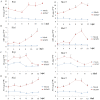Proteomic and phytohormone analysis of the response of maize (Zea mays L.) seedlings to sugarcane mosaic virus
- PMID: 23894637
- PMCID: PMC3720893
- DOI: 10.1371/journal.pone.0070295
Proteomic and phytohormone analysis of the response of maize (Zea mays L.) seedlings to sugarcane mosaic virus
Abstract
Background: Sugarcane mosaic virus (SCMV) is an important virus pathogen in crop production, causing serious losses in grain and forage yields in susceptible cultivars. Control strategies have been developed, but only marginal successes have been achieved. For the efficient control of this virus, a better understanding of its interactions and associated resistance mechanisms at the molecular level is required.
Methodology/principal findings: The responses of resistant and susceptible genotypes of maize to SCMV and the molecular basis of the resistance were studied using a proteomic approach based on two-dimensional polyacrylamide gel electrophoresis (2-DE) and matrix-assisted laser desorption/ionization time of flight mass spectrometry (MALDI-TOF-MS/MS) analysis. Ninety-six protein spots showed statistically significant differences in intensity after SCMV inoculation. The classification of differentially expressed proteins showed that SCMV-responsive proteins were mainly involved in energy and metabolism, stress and defense responses, and photosynthesis. Most of the proteins identified were located in chloroplasts, chloroplast membranes, and the cytoplasm. Analysis of changes in phytohormone levels after virus inoculation suggested that salicylic acid, abscisic acid, jasmonic acid, and azelaic acid may played important roles in the maize response to SCMV infection.
Conclusions/significance: Among these identified proteins, 19 have not been identified previously as virus-responsive proteins, and seven were new and did not have assigned functions. These proteins may be candidate proteins for future investigation, and they may present new biological functions and play important roles in plant-virus interactions. The behavioural patterns of the identified proteins suggest the existence of defense mechanisms operating during the early stages of infection that differed in two genotypes. In addition, there are overlapping and specific phytohormone responses to SCMV infection between resistant and susceptible maize genotypes. This study may provide important insights into the molecular events during plant responses to virus infection.
Conflict of interest statement
Figures








Similar articles
-
Comparative proteomic analysis of the plant-virus interaction in resistant and susceptible ecotypes of maize infected with sugarcane mosaic virus.J Proteomics. 2013 Aug 26;89:124-40. doi: 10.1016/j.jprot.2013.06.005. Epub 2013 Jun 14. J Proteomics. 2013. PMID: 23770298
-
Identification of differentially regulated maize proteins conditioning Sugarcane mosaic virus systemic infection.New Phytol. 2017 Aug;215(3):1156-1172. doi: 10.1111/nph.14645. Epub 2017 Jun 19. New Phytol. 2017. PMID: 28627019
-
Characterization of maize translational responses to sugarcane mosaic virus infection.Virus Res. 2019 Jan 2;259:97-107. doi: 10.1016/j.virusres.2018.10.013. Epub 2018 Oct 21. Virus Res. 2019. PMID: 30355529
-
Maize-Pathogen Interactions: An Ongoing Combat from a Proteomics Perspective.Int J Mol Sci. 2015 Nov 30;16(12):28429-48. doi: 10.3390/ijms161226106. Int J Mol Sci. 2015. PMID: 26633370 Free PMC article. Review.
-
Striking a growth-defense balance: Stress regulators that function in maize development.J Integr Plant Biol. 2024 Mar;66(3):424-442. doi: 10.1111/jipb.13570. Epub 2024 Jan 2. J Integr Plant Biol. 2024. PMID: 37787439 Review.
Cited by
-
Proteo-Molecular Investigation of Cultivated Rice, Wild Rice, and Barley Provides Clues of Defense Responses against Rhizoctonia solani Infection.Bioengineering (Basel). 2022 Oct 20;9(10):589. doi: 10.3390/bioengineering9100589. Bioengineering (Basel). 2022. PMID: 36290557 Free PMC article.
-
Glutathione S-Transferase Enzymes in Plant-Pathogen Interactions.Front Plant Sci. 2018 Dec 21;9:1836. doi: 10.3389/fpls.2018.01836. eCollection 2018. Front Plant Sci. 2018. PMID: 30622544 Free PMC article. Review.
-
Chloroplast in Plant-Virus Interaction.Front Microbiol. 2016 Oct 4;7:1565. doi: 10.3389/fmicb.2016.01565. eCollection 2016. Front Microbiol. 2016. PMID: 27757106 Free PMC article. Review.
-
Comparative proteomics combined with analyses of transgenic plants reveal ZmREM1.3 mediates maize resistance to southern corn rust.Plant Biotechnol J. 2019 Nov;17(11):2153-2168. doi: 10.1111/pbi.13129. Epub 2019 Apr 23. Plant Biotechnol J. 2019. PMID: 30972847 Free PMC article.
-
"Salicylic acid enhances thermotolerance and antioxidant defense in Trigonella foenum graecum L. under heat stress".Heliyon. 2024 Mar 11;10(6):e27227. doi: 10.1016/j.heliyon.2024.e27227. eCollection 2024 Mar 30. Heliyon. 2024. PMID: 38545154 Free PMC article.
References
-
- Bengtsson M, Shen Y, Oki T (2006) A SRES-based gridded global population dataset for 1990–2100. Popul Environ 28: 113–131.
-
- Safarnejad MR, Jouzani GS, Tabatabaie M, Twyman RM, Schillberg S (2011) Antibody-mediated resistance against plant pathogens. Biotechnol Adv 29: 961–971. - PubMed
-
- Xia XC, Melchinger AE, Kuntze L, Lübberstedt T (1999) Quantitative trait loci mapping of resistance to Sugarcane Mosaic Virus in maize. Phytopathology 89: 660–667. - PubMed
-
- Wu LJ, Zu XF, Wang SX, Chen YH (2012) Sugarcane mosaic virus-Long history but still a threat to industry. Crop Prot 42: 74–78.
-
- Pandey A, Mann M (2000) Proteomics to study genes and genomes. Nature 405: 837–846. - PubMed
Publication types
MeSH terms
Substances
LinkOut - more resources
Full Text Sources
Other Literature Sources

